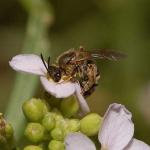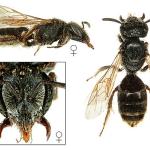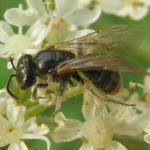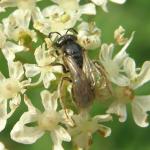Lasioglossum immarginatum SCHENCK 1853
The inner spur of the hind tibia of the female is diagnostic for this bee in Britain, the teeth being broad and rounded apically, rather than narrow and pointed.
Southern England and the Channel Islands (Jersey). Scarce and very local but occasionally abundant where it is found. The species is apparently confined to the western Palaearctic, where it occurs from Britain east to the Urals, and south to North Africa (Morocco) and Iran.
Listed as Nationally Scarce (Na) by Falk (1991).
Mainly open sites, including chalk grassland and woodland.
Females from mid April to late September, males from July to October.
Nests in small to large aggregations, mainly on level, sparsely vegetated soil. Nesting habits are described by Pesenko, Banaszak, Radchenko & Cierzniak (2000). The turret-like nest entrance is illustrated by Westrich (1989). A eusocial species, the workers being smaller than the gynes.
These include bramble (Rubus sp.), common fleabane (Pulicaria dysenterica), dandelion (Taraxacum officinale) and hogweed (Heracleum sphondylium).
None reported from Britain.
2005





